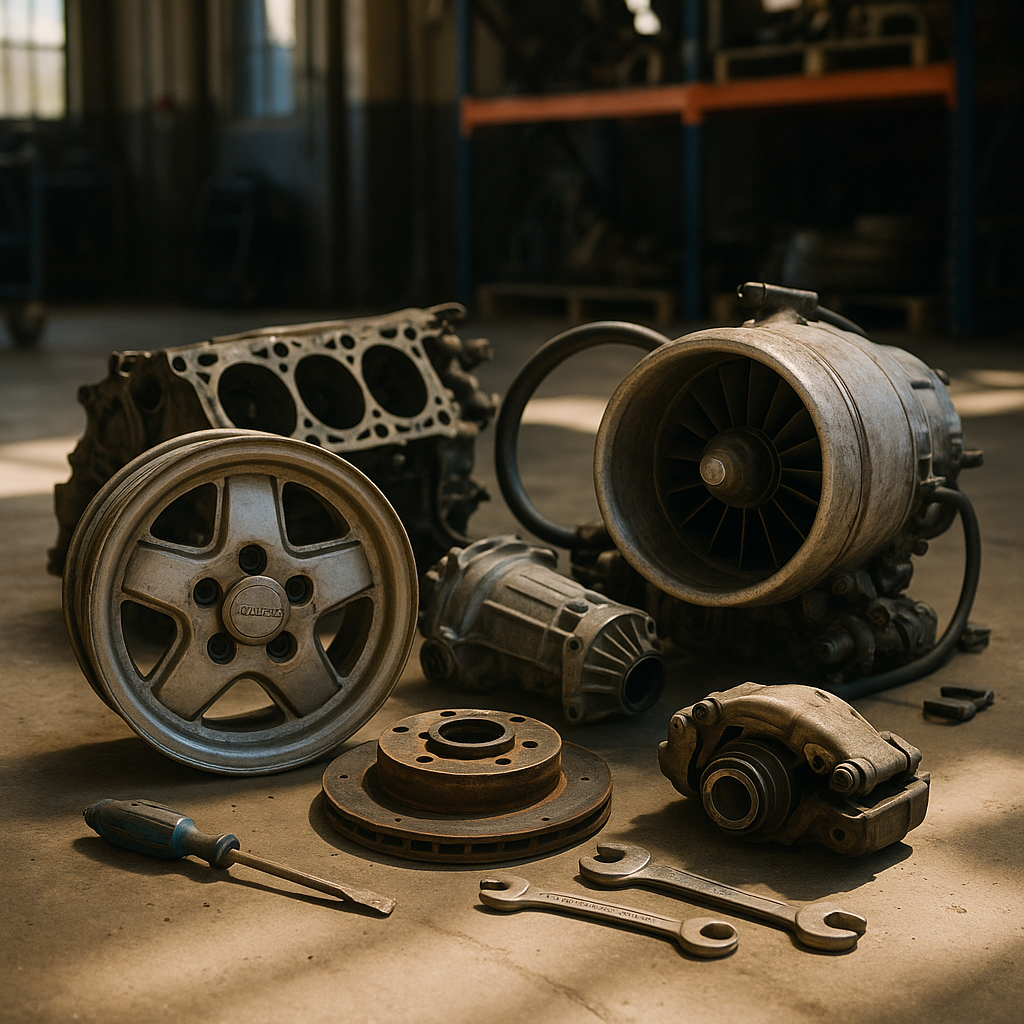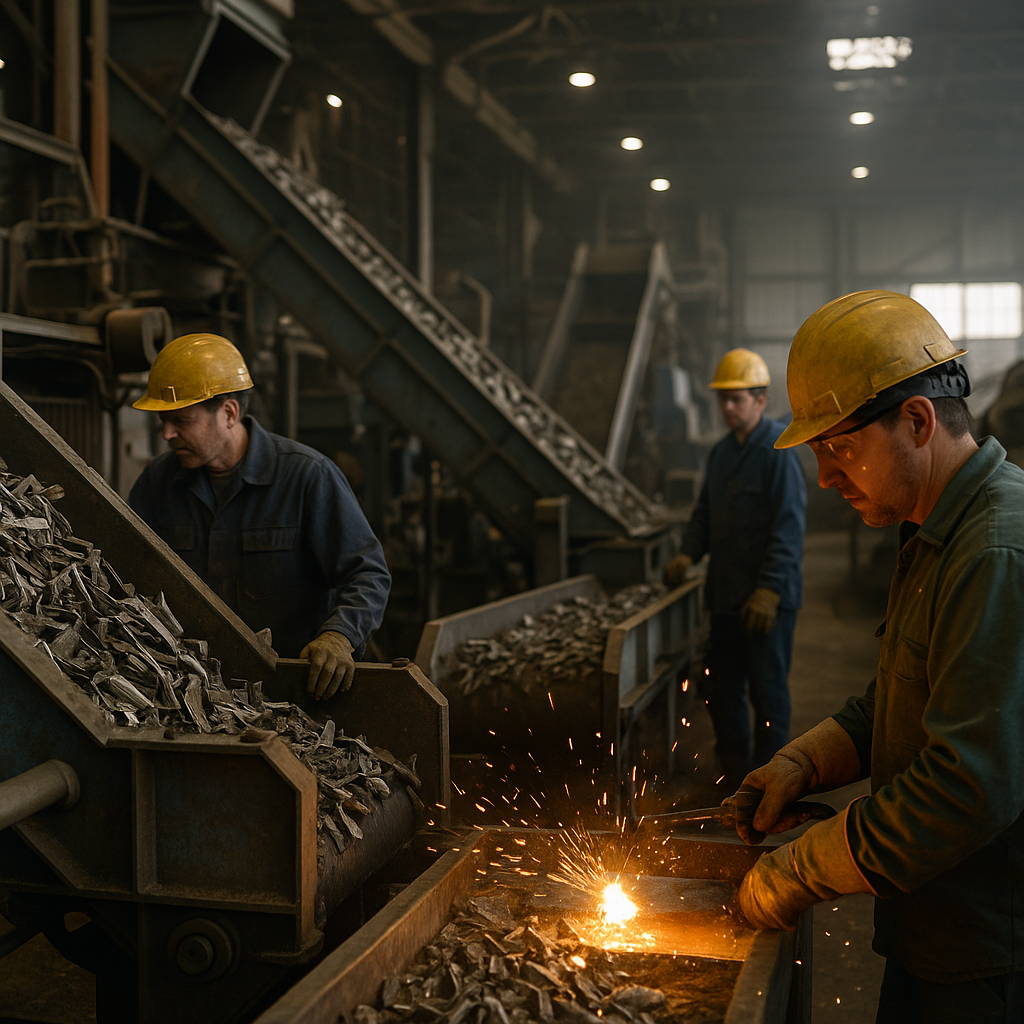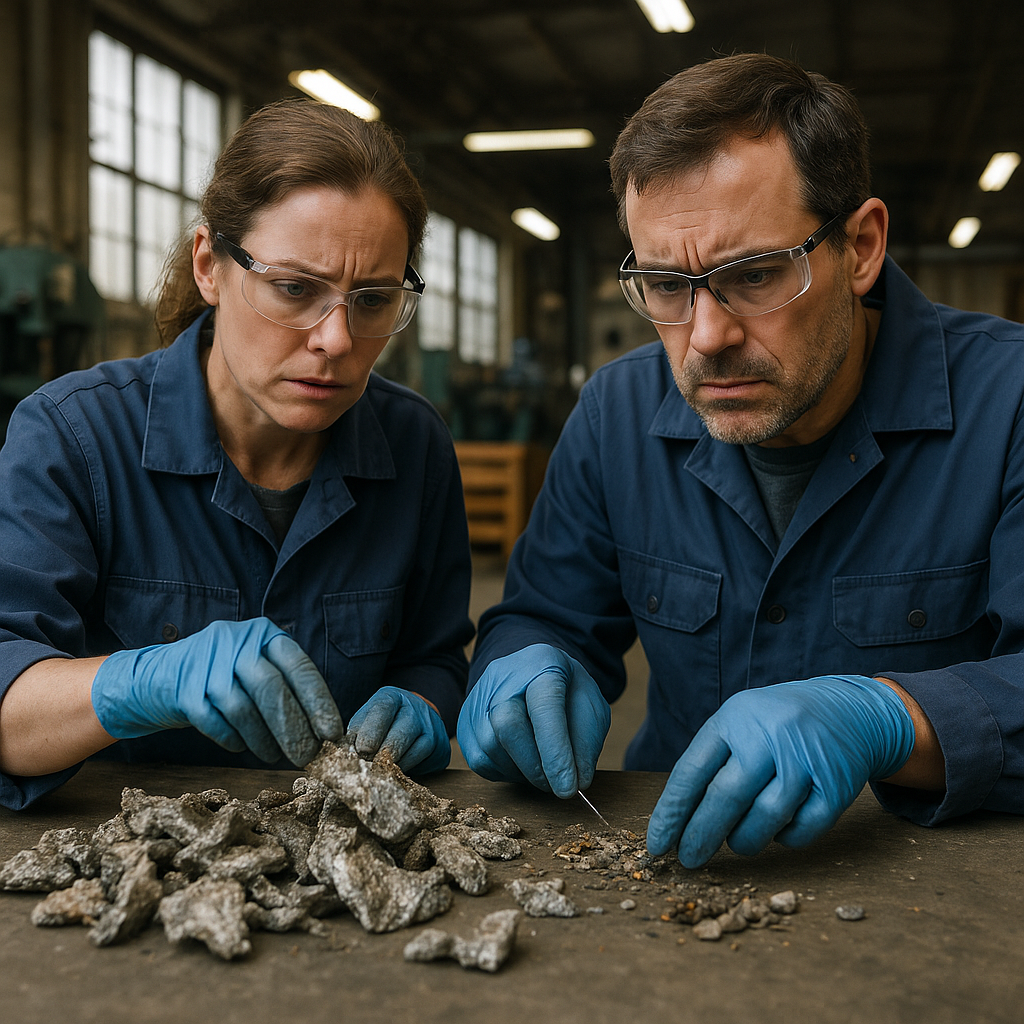5901 Botham Jean Blvd, Dallas, TX 75215
Magnesium Recycling Process: Methods, Challenges, and Emerging Innovations
October 11, 2025Magnesium recycling transforms discarded metal into valuable reusable material. This process captures magnesium scrap from automotive foundries, die-casting operations, and consumer products before it enters the waste stream. The lightweight metal—even lighter than aluminum—offers significant environmental benefits when recycled instead of newly produced.
The process begins with the collection of magnesium-containing items from various sources. These include automotive parts, beverage cans, spark plugs, electronics, and recoveries from manufacturing processes. After collection, materials are sorted to separate pure magnesium from alloys and remove contaminants that might affect quality.
The environmental impact of recycling magnesium is significant. Primary magnesium production in China typically generates over 20 kilograms of CO2 per kilogram of metal. In contrast, the recycling process produces less than 0.6 kilograms of CO2 per kilogram—a reduction of approximately 95% in carbon emissions.
What are the Main Sources of Magnesium Scrap?

Magnesium scrap falls into two categories: new scrap and old scrap. Each type comes from different sources and requires specific handling in the recycling process.
New Scrap Sources
New magnesium scrap is generated during manufacturing processes. In the magnesium industry, diecasting operations produce most of the new scrap. In these operations, about 50% of the material becomes finished products, while the rest turns into scrap.
The new scrap from diecasting includes various components. Approximately 80% of it consists of trimmings, which are excess materials cut away from finished products. Around 8% becomes dross during melting, and chips make up roughly 7%, created during cutting and machining operations.
Reject parts contribute about 4.5% of new scrap volume. These are finished components that fail quality checks due to defects in the casting process. Type I scrap, considered high-grade, includes gates, runners, and drippings from diecasting operations that remain uncontaminated by oils.
Old Scrap Sources
Old scrap, also known as post-consumer scrap, comes from products that have completed their useful life cycle. Used aluminum beverage cans are the largest source of old magnesium scrap, accounting for about 42% of the total. The high recycling rate of aluminum cans (about 63%) makes them a reliable source for magnesium recovery.
Automotive components form the second largest category at approximately 35% of old magnesium scrap. These include both magnesium-base and aluminum-base alloys from various vehicle parts. As automakers increase their use of magnesium for weight reduction, this source continues to grow in importance.
Tools and machinery contribute about 19% of old magnesium scrap, including hand tools, lawnmower decks, and industrial equipment containing magnesium components. Other sources make up the remaining 4%, such as computer parts, sporting goods, and photoengraving plates.
Magnesium Scrap Classification
The recycling industry classifies new magnesium scrap into four types based on quality. Type I represents high-grade uncontaminated scrap. Type II consists of oil-contaminated scrap. Type III includes dross from magnesium processing operations. Type IV comprises chips and fines, which are more challenging to process.
Both magnesium-base and aluminum-base scraps undergo processing in the recycling industry. The difference lies in how the magnesium is recovered. In magnesium-base scrap, the metal is directly reprocessed. In aluminum alloys, the magnesium remains as an alloying element during recycling.
How is Magnesium Scrap Processed and Recycled?

The recycling of magnesium scrap is a multi-stage process that transforms various forms of waste into valuable reusable material. The process consists of several key steps, each crucial for achieving high-quality recycled magnesium.
Scrap Classification and Sorting
Before processing begins, magnesium scrap is classified and sorted, typically based on alloy composition and contamination level. Scrap is categorized from high-grade clean scrap (Class 1) to contaminated post-consumer scrap (Class 7).
Sorting techniques include visual inspection, where experienced workers identify magnesium by its appearance. Magnesium can be distinguished from aluminum by scratching the metal with a knife—magnesium tends to flake, while aluminum curls. Advanced facilities use spectroscopic methods such as X-ray fluorescence (XRF) or laser-induced breakdown spectroscopy (LIBS) for precise sorting.
Pre-Treatment of Scrap
Low-grade scrap often requires pre-treatment before melting. Magnesium chips from machining operations may be contaminated with cutting oils and moisture, which must be removed to prevent oxidation and dangerous reactions during melting.
For coated magnesium parts from post-consumer sources, de-coating is essential. This can be achieved through mechanical means (sandblasting or wet blasting), chemical stripping with solvents or alkaline solutions, or thermal methods where the coatings are burned off at temperatures between 400-550°C.
Melting and Flux Refining
Once sorted and pre-treated, magnesium scrap is melted in steel crucibles at approximately 675°C. Flux is added to protect the molten metal from oxidation and to help remove impurities. Common fluxes consist of various chloride and fluoride salts, typically including MgCl₂, KCl, CaCl₂, BaCl₂, NaCl, and CaF₂ in different proportions.
The flux works by altering the interfacial tension between the melt and inclusions, causing impurities to agglomerate into larger particles that can then settle to the bottom of the melt. The chemical reaction can be represented as:
MgCl₂(l) + MgO(s) = MgCl₂·MgO(s)↓
In facilities using fluxless melting, protective gases such as SF₆ or newer alternatives like HFC-134a are employed instead of flux to prevent surface burning.
Impurity Removal
Harmful impurities, especially iron (Fe), copper (Cu), and nickel (Ni), must be removed as they drastically reduce corrosion resistance in recycled magnesium. Iron, the most common impurity, is typically removed by adding manganese (Mn), which forms intermetallic compounds with Fe that settle out of the melt.
Other additives for impurity removal include rare earth elements, boron, titanium, and zirconium. Each forms compounds with specific impurities that can then be separated from the melt. For example, adding 0.2 wt.% yttrium to a Mg-3Al melt can reduce Fe content from 291 to 51 ppm, significantly improving corrosion resistance.
Refining Methods
Beyond flux refining, several other methods may be employed for purification:
Inert gas sparging involves injecting argon gas into the melt to create fine bubbles. These bubbles attract inclusions and hydrogen, carrying them to the surface for removal.
Filtration passes the melt through ceramic foam filters (typically made of Al₂O₃ or MgO) to trap solid inclusions. Modern filters can effectively remove particles as small as 10-20 μm.
Ultrasonic treatment applies high-frequency sound waves to generate cavitation bubbles that help degas the melt and cause inclusions to coalesce for easier removal.
For highly contaminated scrap, vacuum distillation may be used, where magnesium is vaporized under vacuum (below 100 Pa) and temperatures of 650-700°C, leaving impurities behind in the residue.
Casting and Solidification
After refining, the molten magnesium is transferred to ingot molds through hand ladling, pumping, or tilt pouring. The metal solidifies into ingots that can be used as feedstock for new magnesium products.
Alternative Recycling Routes
Not all magnesium scrap follows the melting route. Clean magnesium chips can be directly ground into powder for use in steel desulfurization. In this application, magnesium combines with sulfur in steel to form magnesium sulfide, which can be easily separated.
Solid-state recycling methods are also emerging, where magnesium chips are consolidated through processes like hot extrusion or equal channel angular pressing (ECAP). These methods skip the melting stage entirely, saving energy and avoiding oxidation losses.
Used Beverage Can Recycling
A significant quantity of magnesium exists in aluminum beverage cans, where it serves as an alloying element (approximately 4.5% in the lid and 1.1% in the can body). When these cans are recycled, the magnesium remains with the aluminum rather than being separated.
The recycling process involves delaquering and melting the cans, with about 90% of the magnesium content being recovered in the recycled aluminum. This magnesium continues to serve its purpose as a strengthening agent in the recycled aluminum cans, completing a closed-loop recycling process.
What are the Challenges in Magnesium Recycling?

Despite its substantial potential for energy savings and environmental benefits, magnesium recycling faces significant challenges, resulting in lower recycling rates compared to other metals. These challenges encompass the entire recycling chain, from collection to processing.
Collection and Sorting Limitations
One primary barrier to efficient magnesium recycling is the lack of established collection mechanisms. Unlike aluminum cans or steel components, magnesium-containing products often lack dedicated recovery systems. Many magnesium applications are dissipative, meaning they are used in ways that hinder recovery.
The sorting system for magnesium scrap is inadequate. Current technologies struggle to quickly and accurately identify different magnesium alloys, which is crucial for producing high-quality recycled material. Without proper sorting, contaminants can compromise the integrity of recycled magnesium.
Technical Processing Challenges
Separating magnesium from complex products presents significant technical challenges. Modern consumer goods often feature magnesium parts embedded with other materials, complicating disassembly and sometimes rendering it uneconomical. Coatings, paints, and other surface treatments further complicate the recycling process.
Most clean magnesium scrap from manufacturing is effectively recycled in closed-loop systems. However, post-consumer scrap recycling remains limited, with much of this material discarded in landfills rather than recovered.
Environmental Concerns with SF6
The use of sulfur hexafluoride (SF6) as a protective cover gas in magnesium casting and recycling operations presents serious environmental issues. SF6 has an extremely high global warming potential, approximately 23,500 times that of carbon dioxide over a century. With an atmospheric lifetime exceeding 3,200 years, even small emissions of SF6 can have prolonged climate impacts.
The industry faces increasing regulatory pressure to reduce or eliminate SF6 use. The European Union and other governments have implemented strict regulations to curb SF6 emissions, encouraging the industry to explore alternative solutions.
Emerging Solutions and Innovations
The magnesium industry is actively exploring alternatives to address these recycling challenges. Lower-impact cover gases are gaining traction, including fluorinated ketones, HFC-134a, and newer options like NovecTM 612, which has a global warming potential of just 1 (compared to SF6’s 23,500) and an atmospheric lifetime of only 3 days.
Advanced sorting technologies are enhancing the identification and separation of magnesium alloys. Laser-induced breakdown spectroscopy (LIBS) shows promise for more accurate sorting, while new mechanical and chemical techniques facilitate the removal of coatings and separation of magnesium from complex products.
Innovative recycling processes, such as solid-state recycling techniques, convert magnesium chips directly into new products with minimal energy input. These methods bypass the melting stage, significantly reducing both energy consumption and emissions.
Economic Factors
Economic considerations remain a key challenge for magnesium recycling. The cost of collecting, sorting, and processing post-consumer magnesium often exceeds the value of the recovered metal. Without financial incentives or regulatory mandates, businesses may lack motivation to invest in magnesium recycling infrastructure.
However, as primary magnesium production costs increase due to environmental regulations and energy prices, recycled magnesium is becoming more competitive. This shifting economic landscape may eventually make magnesium recycling more financially attractive, spurring greater investment and innovation in the field.
Conclusion: The Future of Magnesium Recycling
The magnesium recycling industry is on the brink of significant transformation and growth. With global demand for magnesium projected to reach $6.59 billion by 2029, at a CAGR of 7.30%, the recycling sector is set to play an increasingly essential role in sustainably meeting this demand. The automotive sector drives much of this growth as manufacturers seek lightweight materials to enhance fuel efficiency and reduce emissions.
The future of magnesium recycling will likely see notable advancements in several key areas. Collection systems are expected to become more sophisticated, improving the recovery of post-consumer scrap that often ends up in landfills. Technological innovations such as vacuum gasification-directional condensation show promise in producing higher purity recycled magnesium. Additionally, developments in solid-state recycling offer ways to process magnesium with minimal energy use. The industry is also moving toward environmentally sound practices by developing alternatives to SF6 cover gases, with options like NovecTM 612 significantly reducing greenhouse gas impacts.
As the magnesium recycling sector evolves, it will play a crucial role in fostering a more circular economy—conserving valuable resources, reducing energy consumption, and minimizing environmental impacts. For your recycling needs and to learn more about sustainable magnesium recovery solutions, contact Okon Recycling at 214-717-4083.
